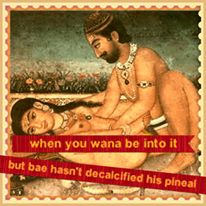
On this Easter Sunday, I am very happy to announce formally here on this blog the completion of a new book by Dr Nida Chenagtsang and Sky Press, Karmamudra: The Yoga of Bliss (Sexuality in Tibetan Medicine and Buddhism).
As some of you may know, I have been working as editor and translator for this project since 2016. In so many ways, it has been unlike anything I have worked on before. Dr Nida will be presenting the book at the 6th annual Tibetan Traditional Medicine Sorig Congress in Pisa, Italy in three weeks and it will be launched worldwide on April 25th. Here is the blurb for the book from Sky Press’ website:
“Karmamudra refers to the ancient Buddhist practice of partnered sexual yoga. Also known as ‘The Path of Skillful Means’ or ‘The Path of Great Bliss’, Karmamudra uses powerful meditation techniques to transform ordinary pleasure, worldly desire, and orgasm into vehicles for spiritual transformation and liberation. In this ground-breaking book, Dr Nida Chenagtsang draws on his extensive training in Tibetan medicine and yoga to clarify major misconceptions relating to Tibetan Buddhist Tantra in general and Tibetan Buddhist sexual yoga practices in particular. Demystifying sexual yoga without depreciating it, Dr Nida provides an overview of the relationship between Sutric and Tantric orientations in Tibetan Buddhism, offers explanations of Tantric vows, initiations, and subtle anatomy, and explores both bio-medical and traditional Tibetan ideas about sexual health and well-being.
Speaking in a colloquial style as a physician, teacher, yogi, and parent, he addresses issues of sexual abuse, well-being and empowerment in a learned, down-to-earth and compassionate way. Aiming to inform and empower, this book offers vital context and instructions through which beginner and advanced students of any gender or sexual orientation can learn to engage with typically destructive and distracting emotions in a skillful way. Drawing on special Karmamudra teachings found in the Yuthok Nyingthig tradition that are aimed at practitioners without any prior training in Tantric yoga, it offers safe and simple methods through which students can work with the raw energy of their desire and transform it into a source of blessings and benefit in their everyday lives.
Continue reading →








